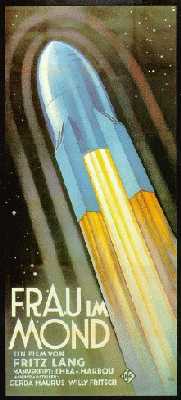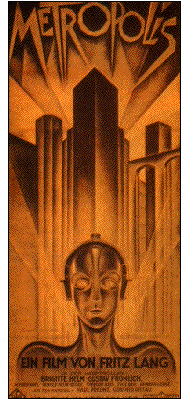Fritz Lang
Fritz Lang was an Austrian-born American film director, born in Vienna and educated there at the College of Technical Sciences and the Academy of Graphic Arts. He wanted to become a painter but in 1919 joined the Decla Film Company. In 1926 in Berlin he directed two Dr. Mabuse films, and Metropolis, a nightmare of the future where a large section of the population is reduced to slavery. When Hitler came to power in 1933, Goebbels, a fan of Lang's films, asked Lang to make propaganda films for the Nazis. Lang refused and immediately fled to Paris and then to the U.S. He died in Beverly Hills, California.
This is the original poster for Frau im Mond (Woman in the Moon), directed by Fritz Lang and released in 1929.
|
This is the original poster for Metropolis, directed by Fritz Lang and released in 1926.
|
Partial Filmography
Die Spinnen (1919) Karl De Vogt, Lil Dagover. This early Lang effort is more reminiscent of The Perils of Pauline (1914) than later Lang films, but who cares?
Destiny (Der Mude Tod) (1921) Lil Dagover, Bernhard Goetzke. We finally found a decent print of this film. It's still a bit murky, but much cleaner than any other print. Dagover's lover dies and she pleads with Death (Goetzke) to return her betrothed. He responds with a challenge: if she can save just one of three doomed men from their fate, she can have her wish.
Dr. Mabuse, The Gambler (1922) Rudolf Klein-Rogge, Bernhard Goetzke. Super-criminal Mabuse is out to make a fortune and run Berlin. Detective Wenk (Goetzke) is out to stop him. Wenk begins to unravel Mabuse's criminal organization, but it seems Mabuse is already plotting to have the detective killed.
Siegfried (1924) Paul Richter. The German epic, told without resorting to Wagnerian opera. Siegfried helps weak King Gunther win the hand of Brunhild. She then arranges for the hero's death.
Kriemhild's Revenge (1924) Rudolf Klein-Rogge. With Siegfried murdered in the last reel of the preceding film, his widow, Kriemhild, vows vengeance on his murderers. To accomplish this, she enlists the aid of Attila the Hun (Rogge), who marries her and fathers a child. Kriemhild gets her revenge, but loses everything in its pursuit.
Metropolis (1926) Brigitte Helm, Klein-Rogge. Some people love this film, and others hate it, but no one can argue that it is one of the milestones of early s/f cinema. Lang's financial backing, UFA studios, eventually went bankrupt because this film never made its money back. Helm plays a member of the underground (literally) movement rebelling against the rich rulers of the futuristic city.
Spies (1928) Gerda Maurus, Rudolf Klein-Rogge. This is one of Lang's most overlooked films, yet it is just as good as much of his earlier work. Klein-Rogge is villain Haghi--a man who leads a double life, dabbling in a circus but running a huge crime syndicate.
The Woman in the Moon (Die Frau im Mond) (1929) Censored in Germany during WWII, this film tells the story of a group of people who develop a moon rocket. While some of the details are silly, the actual launch of the rocket and its design are extremely similar to the Apollo series in the '60s. Willy Ley, an advisor for this film, had ideas which influenced both Hitler's V2 project and our own Apollo missions.
M (1931) Peter Lorre. This is perhaps Lang's best film. Lorre is a psychotic child murderer whose crimes are so atrocious that the police step up their operations for a manhunt. The city's criminal population, however, feels new constraint because of the extra patrols and they launch their own search. The suspense builds as both criminal and police patrols close in on Lorre's whereabouts. The ending of this film is phenomenal. The Testament of Dr. Mabuse (1932) In 1932, Fritz Lang made a sequel to his 1922 Dr. Mabuse films which incensed the Nazi party. They banned the film, but asked Lang to make propaganda features for them. He left the next day with the banned film. It was thought to be lost for some time, but prints have now resurfaced.
Crimes of Dr. Mabuse (1943) The original title, The Testament of Dr. Mabuse, was changed to The Crimes of Dr. Mabuse for its eventual US release in 1943. The plot concerns an asylum director who follows Mabuse's plans for spectacular crimes.
Scarlet Street (1944) Edward G. Robinson. A nice piece of film noir from the forties. Lots of dark lighting and moody shadows. One of Lang's better-liked American films.
The 1000 Eyes of Dr. Mabuse (1960) Gert Frobe, Peter Van Eyck. Lang's last film, made in Germany, is his final chapter in the Mabuse saga. Frobe investigates strange crimes centered at the Hotel Luxor. The opening scene is a modernized version of the famous assassination sequence from the 1932 Mabuse film.

